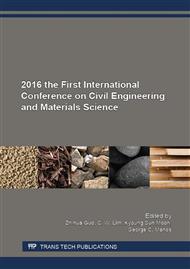[1]
R. Kumar, B. Bhattacharjee, Study on some factors affecting the results in the use of MIP method in concrete research. Cem. and Concr Res. 33(2003) 417-424.
DOI: 10.1016/s0008-8846(02)00974-2
Google Scholar
[2]
S.G. Patil, A study on porosity and pore size distribution obtained through MIP of cement paste and cement sand mortar incorporating silica fume, PhD thesis 2006; Indian Institute of Technology Delhi.
Google Scholar
[3]
D.H. Bager, E.J. Sellevold, Mercury porosimetry of hardened cement pastes: the influence of particle size. Cem. and Concr Res. 5(1975) 171-175.
DOI: 10.1016/0008-8846(75)90075-7
Google Scholar
[4]
R. Kumar, B. Bhattacharjee, Porosity, pore size distribution and in situ strength of concrete. Cem. and Concr Res. 33(2003) 155-164.
DOI: 10.1016/s0008-8846(02)00942-0
Google Scholar
[5]
B. Kondraivendhan, B. Bhattacharjee, Effect of age, w/c ratio on size and dispersion of pores in ordinary Portland cement paste. J. ACI Mater 107(2010) 147-154.
DOI: 10.14359/51663578
Google Scholar
[6]
R. Kumar, Strength and Permeation Quality of Concrete through Mercury Intrusion Porosimetry. PhD Thesis 1997; Indian Institute of Technology Delhi.
Google Scholar
[7]
IS: 8112-1989(Reaffirmed 2005). Specification for 43 grade ordinary Portland cement. Bur. of Indian Stand. New Delhi.
Google Scholar
[8]
IS: 12269-1987. Specification for 53 grade ordinary Portland cement. Bur. of Indian Stand. New Delhi.
Google Scholar
[9]
R. F. Feldman, J.J. Beaudoin, Pretreatment of hardened hydrated cement pastes for Mercury Intrusion Measurements. Cem. and Concr Res. 21(1991) 297-308.
DOI: 10.1016/0008-8846(91)90011-6
Google Scholar
[10]
S.A. Diamond, critical comparison of mercury intrusion porosimetry and capillary condensation pore size distribution of Portland cement pastes. Cem. and Concr Res. 1(1971) 531-45.
DOI: 10.1016/0008-8846(71)90058-5
Google Scholar
[11]
T. Luping, A study of the quantitative relationship between strength and pore size distribution of the porous materials. Cem. and Concr Res. 16(1986) 87-96.
DOI: 10.1016/0008-8846(86)90072-4
Google Scholar
[12]
S.G. Patil, B. Bhattacharjee, Size and volume relationship of pore for construction materials. J. Mater. Civ. Eng. 20(2008) 410-418.
DOI: 10.1061/(asce)0899-1561(2008)20:6(410)
Google Scholar


